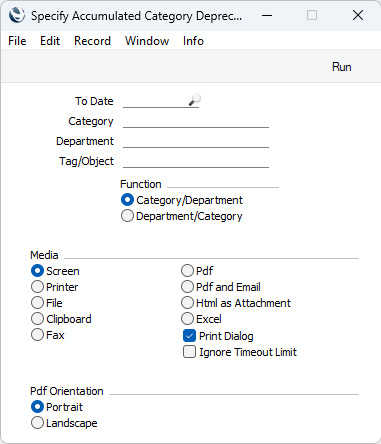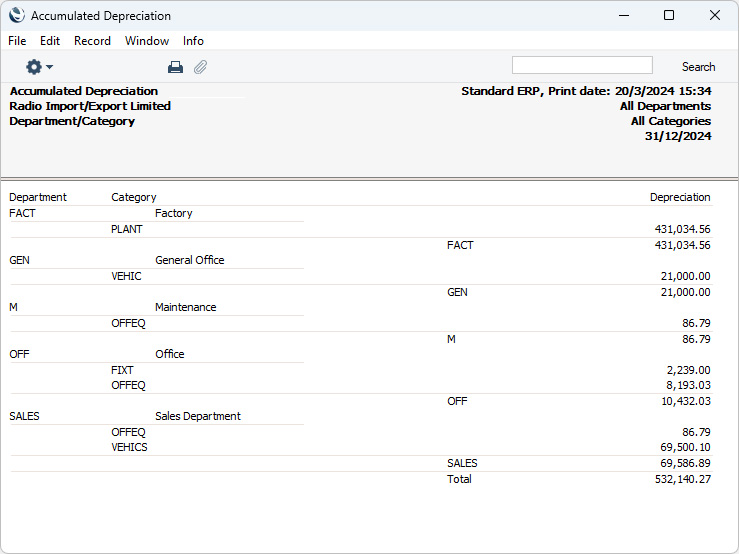Accumulated Category Depreciation
This page describes the Accumulated Category Depreciation report in the Assets module.
---
The Accumulated Category Depreciation report is a list of Department/Category combinations showing the total depreciation to a specified date of the Assets in each one. Assets that do not have a Department are not shown in the report.

- To Date
- Paste Special
Choose date
- The report calculates depreciation for the life of each Asset to the date that you specify here. You must enter a date or the report will be empty.
- Category
- Paste Special
Asset Category register, Assets module
- Range Reporting Alpha
- If you want to report on the Assets belonging to a particular Category, specify that Category here. You can also enter a range of Assets separated by a colon (:).
- Department
- Paste Special
Departments setting, Assets/Human Resources Management/System module
- Range Reporting Alpha
- If you want to report on the Assets belonging to a particular Department, specify that Department here.
- If an Asset has been moved between Departments before the To Date specified above using Asset Status records of Type "Movement", its depreciation will be divided between each Department depending on the time it spent in each one.
- Tag/Object
- Paste Special
Tag/Object register, Nominal Ledger/System module
- Specify a Tag/Object in this field if you want the figures in the report to be calculated for Assets with a certain Tag/Object. If the field is empty, all Assets, with and without Tag/Object, will be included in the calculations. If you enter a number of Tags/Objects separated by commas, the calculations will only include Assets featuring all the Tags/Objects that you have entered. If you enter a number of Tags/Objects separated by plus signs (+), all Assets featuring at least one of the Tags/Objects listed will be included. If you enter a Tag/Object preceded by an exclamation mark (!), all Assets featuring any Tag/Object except the one listed will be included.
- For example:
- 1,2
- Includes Assets with Tags/Objects 1 and 2 (Assets with Tags/Objects 1, 2 and 3 will be included).
- 1+2
- Includes Assets with Tags/Objects 1 or 2.
- !2
- Includes all Assets except those with Tag/Object 2.
- 1,!2
- Includes Assets with Tag/Object 1 but excludes those with Tag/Object 2 (i.e. Assets with Tags/Objects 1 and 2 will not be included). Note the comma before the exclamation mark in this example.
- !1,!2
- Includes all Assets except those with Tag/Object 1 or 2 or both. Again, note the comma.
- !(1,2)
- Includes all Assets except those with Tags/Objects 1 and 2 (Assets with Tags/Objects 1, 2 and 3 will not be included).
- !1+2
- Includes Assets without Tag/Object 1 and those with Tag/Object 2 (Assets with Tags/Objects 1 and 2 will be included).
- (1,2)+(3,4)
- Includes Assets with Tags/Objects 1 and 2, and those with Tags/Objects 3 and 4.
- 1*
- Includes Assets with Tags/Objects beginning with 1 (e.g. 1, 10, 100).
- 1*,!1
- Includes Assets with Tags/Objects beginning with 1 but not 1 itself.
- *1
- Includes Assets with Tags/Objects ending with 1 (e.g. 1, 01, 001).
- 1*,*1
- Includes Assets with Tags/Objects beginning and ending with 1.
- Function
- The two formats available for this report are illustrated below:
- Category/Department
- In this report, the Assets are sorted by Category and then by Department. Depreciation figures for each Asset are not shown. Instead, total depreciation figures for each Category are shown, with subtotals for each Department within the Category.

- Department/Category
- This option is similar, but the Assets are sorted by Department and then by Category. Total depreciation figures for each Department are shown, with subtotals for each Category within the Department.

---
Go back to:
